|
|
|
Greetings to all readers in the sweltering summer,
 |
|
'Nuff said about that. Except to add that the standard opening greeting in formal written Japanese for this season is "Shochu no mimai moshiagemasu," which actually means to express concern over someone, due to the heat. "Are you surviving this?" Like I said: 'nuff said.
Late summer in Japan means fireworks, festivals and quiet in the sake world. It brings cacaphonies of bug noises that people (including me) actually love to hear, punishing humidity that people (including me) somehow tolerate, and outdoor chores that few (including me) seem to get done. Ah, well.
While little takes place in the sake-brewing world, it is a perfect season to enjoy gently chilled, mildly fragrant sake. Don't listen to the beer people - they know not of what they speak. Read more about summer season sake below.
Note, too, that the Sake Professional Course in Chicago took place with a disconcerting level of smoothness, thanks to massive support from all around. And the next Sake Professional Course is scheduled for October 24 to 26 in San Francisco. Read more about that below as well.
Enjoy the dwinding summer, and the newsletter as well,
John
PS: Don't forget that Sake's Hidden Stories and The Sake Notebook are both available for Kindle, Nook and the iPad! See details below.
|
Seasonal Sake: Summer Ginjo
Better than beer to beat the heat!
Perhaps no culture adapts to the changing pulse of the seasons as
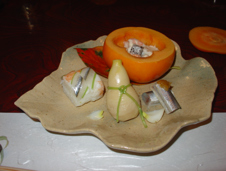 |
|
much as Japan. While this is reflected in everything from clothing to flowers, it is most commonly seen in what people eat and drink. Okashi, or traditional confectionaries, will change in design to match the season as often as every ten days. Enjoying (in particular) fish, fruits and vegetables during their “shun”, or the season in which they peak, always adds a dimension of subtle put perceivable goodness and a definite added enjoyment.
Sake, too, has its seasons of course. Or rather, each season has its sake. While matching sake to the season is surely not as structured as it might be for the aforementioned okashi, most seasons have one or several types of sake that suit them well. And in the hot and muggy summer, surely one such type of sake is natsu ginjo, or “summer ginjo.”
Natsu ginjo is just what it sounds like it might be: ginjo-shu tailored to the summer season. What does this imply? In short, slightly lower alcohol, mildly fragrant, often nama (unpasteurized), and best enjoyed chilled, of course.
 |
|
What we need in a sake in this season is something soft, smooth, light and appealing. The lower alcohol gives us the soft, light and low-impact nature. The ginjo part contributes a mildly aromatic appeal, and this is augmented with freshness by leaving the sake either unpasteurized or lightly pasteurized (to provide at least some stability!). It is common to see natsu ginjo versions of a kura’s flagship products, which can give us “somethin’ different” while couching us in familiarity at the same time. Which is nice, since no one likes to think too hard in the summer!
Note, natsu ginjo is far from an official term, nor is the concept anything that remotely resembles an industry-wide concept. And the particulars like alcohol content and pasteurization will surely vary widely from kura to kura. But there seems enough of a trend out there to consider natsu ginjo a category unto itself, and to sing its praises if just a bit.
In truth, not
that many brewers make a natsu ginjo product. And while certainly some brewers have been making it from long ago, it would still be hard to label it a truly traditional style. Yet it is, for sure, truly suited to its purpose.
Form follows function, as it so often does, in sake as in architecture.
Yet another seasonal way of enjoying sake in the summer is genshu on
 |
|
the rocks. Genshu is sake (of any grade) that has not been cut with water after brewing, which often - but not always - means the alcohol can be closer to 20 percent than the usual 16 percent. Enjoying this over ice lets us sip well chilled sake and enjoy its interesting evolution as it slowly drops from the original alcohol level to something a bit lower as the melting ice dilutes it.
But I personally do not find this as appealing, as evidenced by nothing more complicated than what I find myself reaching for on a hot summer afternoon or evening. Or morning, depending on the day. But I digress.
One of my favorites (although hardly widely available) is Tensei Junmai
 |
|
Ginjo, made by a small brewer in Kanagawa of all places. As is often the case for natsu ginjo, it is only available locally. But it still deserves mention is it is a quintessential example of this style, if a bit more fruity and high in sprightly acidity than most natsu ginjo. Look for it should you pass through Kanagawa or Tokyo.
Indeed, the appropriateness to the summer season of natsu ginjo is unparalleled and simply delicious. It goes down all too quickly, and a bit too fast, as more than one afternoon barbeque has shown. But hey! That’s what summer is for.
|
|
Kuramoto and Kurabito
Owners and Brewers
At the risk of throwing around too many buzzwords…
The word “kuramoto” is a slightly vague term referring to the owner of a
 |
|
sake brewery. It can also refer to the family that owns it; in other words, it does not necessarily refer to the president of the company per se, although it most often implies that. With very, very few exceptions, sake breweries are family run operations spanning several-to-many generations.
“Kurabito,” on the other hand, are the folks that do the actual brewing; in other words, the brewing staff. Their leader, the master brewer, is called the toji. So each kura (brewery) is owned by a kuramoto, and staffed by kurabito that is led by one toji.
Interestingly, the owners of the company are not the folks that actually make the sake; they just sell it. And just as interestingly, they do not really possess the skill or technology to make the sake themselves. That is left up to their skilled craftsmen employees. In truth, this whole system is changing fast, but it does remain more or less intact.
So while we might think the kuramoto has it easy, since all he has to do is schmooze and sell the good stuff, perish the thought. It is the kuramoto’s job to create an environment in which the kurabito can brew, and then stand out of their way, just as it is in turn the kurabito’s job to create an environment in which the sake can brew itself, and then stand out of its way.
At a meeting in “downtown” Tokyo that saw the representatives of each of the prefectures’ local sake-brewing cooperatives in attendance, I glided into a conversation with the president of the company making Hanagaki in Fukui Prefecture, Mr. Takayasu Nanbu. After accepting a small pour of his daiginjo, the harmless chat began with me asking him what was new at his kura, if anything.
“Oh, tons of little stuff. Not much of which has anything directly to do with sake, though. Not directly, that is. Just the typical hassle stuff that we kuramoto have to deal with. You know - safety, liability, peace within the kura walls - stuff like that.”
“Oh?” I inquired, cutting my response short, enticing him to elaborate. As I sipped the soft, round Hanagaki daiginjo, Nanbu-san continued.
“The sake itself, that’s out of my hands. I get them the best Fukui-grown Gohyakumangoku rice, and Hioki-san (the toji) takes it from there. What I have to do is stuff like making sure the kura is as safe to work in as possible, so that no one gets hurt. That, and just generally make sure bad luck has as little a chance to butt in as possible!
What does that entail?
“Aw, you know. Ladders, platforms, stairs, and stuff like that; all of it is
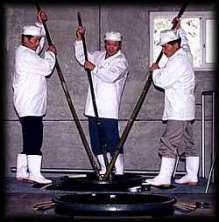 |
|
crucial for peering into fermenting tanks. But they need to be solid and safe, and that means maintenance and replacement. Like, all the time.
“Then, they want their toys. New equipment, new tools, new contraptions that I don't even understand. And some of it is expensive enough to extend my return on investment another millennium or so,” he jokingly lamented.
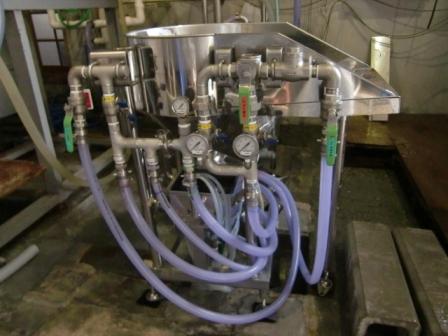 |
|
“And there’s more,” he continued. “I gotta keep the peace!” Sake brewing, especially at small and traditional kura like that making Hanagaki, is intense. You have the entire brewing staff working shoulder to shoulder 12 hours a day for six months. And while some go home at night, commonly the brewing staff live in the kura during that time as well.
“F’rinstance, from this coming season, I have given all the brewing personnel their own tiny room. It ain’t much, just enough room to sleep and rest, but it at least gives them a place of their own, and some semblance of privacy.”
Actually, very few of the 1300 remaining breweries these days has all the brewers living in the kura during the season. Usually one or two might, while the others commute from local homes, perhaps taking turns staying over. Modern gadgets let them set up systems that sends them a text message to their cell phone alerting them when a temperature gets out of range, for example. So today, they can often afford a more reasonable lifestyle. But at Hanagaki, they are still old school, and all of the five-strong brewing staff are kura-bound.
So maintaining the harmony is very important. Sake is alive, and is affected by bad vibes, or so say and feel those that make it. So a little step like giving the kurabito their own space can make the sake taste better.
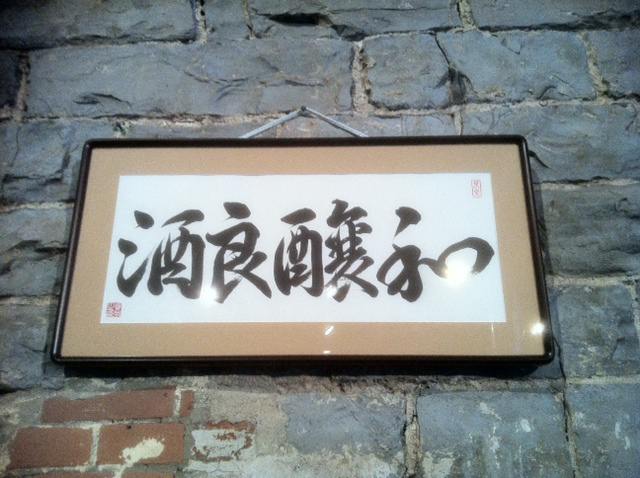 |
|
I have heard more than one story of either the kuramoto or the toji needing to intervene to keep peace. Incessant snoring, a non-stop string of bad puns, and overall cluelessness are all examples of things toji or kuramoto have told me called for intervention to keep the harmony and save the sake.
So in the end, while the toji and kurabito often get the credit, the kuramoto too plays an important role in making great sake, albeit often in the background.
It is also important to emphasize how much the structure of the sake-brewing personnel world is changing. Back in “the day,” the kuramoto rarely set foot into the brewery itself. That was the domain of the toji and his merry men, who lived and brewed there four to six months of each year. But now, perhaps one-fourth of all the kura in the country no longer use toji from the traditional guilds, but rather brew themselves. “Owner-toji,” they are called, and while a rarity just a scant 25 years ago, they are increasingly common, if not necessary, in today’s environment.
And regardless of which social structure exists inside the kura, each and every person, from kuramoto to toji to kurabito, plays an irreplaceable role in creating great sake.
|
|
Sake Basics: What's This "Koji" Stuff?
Psst! It's more than just "moldy rice"
If you spend much time around sake, or even just reading this
newsletter, you will soon come across the term
koji. In fact, at times it seems like sake is all koji-this and koji-that. Which, in fact, is not too far from the truth.
Koji is steamed rice that has had a special mold (koji-kin, or Aspergillus Oryzae) propagated upon it. That mold gives off enzymes that convert starch in the rice into sugars that can be fermented by the yeast. Without koji there can be no sake. And while every single step of the brewing process is of paramount importance, koji making (i.e. just how the mold is allowed to propagate onto the rice) may be the one step that holds the most sway over the nature of the final sake.
But koji is not used by sake brewers alone. Koji is used in making many things, including shoyu (soy sauce), shochu (Japan's distilled beverage), and of course miso. Note too that koji for sake is always made from rice, whereas koji for shoyu, shochu and especially miso can be made from barley.
|
Did You Know? Popular Sake is Popular for a Reason
'Cuz it tastes good!
I recently took part as a judge in a large-scale tasting of hundreds of
sake. And the result seemed almost scripted - with Japan's most popular sake sweeping all top ten awards in all categories. It was uncanny! But it was real, as all the sake was tasted blind, and all the judges were either brewers or other industry professionals.
To learn more about the event, the particulars, and - most interestingly - the winners, please read this recent post on my Sake World blog. You will be surprisingly unsurprised!
Interested in brewing sake at home? Check out Brewing Sake: Release the Toji Within, by Will Auld. Learn more here, or just buy it here
Want to help support Tohoku, and learn about Tohoku cuisine? Nothing goes better with Tohoku sake! Check out Elizabeth Andoh's ebook “Kibo” to do both!
|
 Announcements and Events Announcements and Events
Sake Professional Course
San Francisco, CA, October 24 ~ 26
The next Sake Professional Course will take place on October 24, 25 and 26 at Bentley Reserve in San Francisco, Caifornia. We are currently taking reservations for this course.
The seating for the cours is already about half full (or still half-empty; depending on your personality), and is expected to fill up relatively soon after this formal announcement.
The Sake Professional Course, with Sake Education Council-recognized Certified Sake Professional certification testing, is by far the most intensive, immersing, comprehensive sake educational prog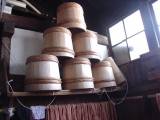 ram in existence. Three days of classroom lectures and tastings leave "no sake stone unturned." ram in existence. Three days of classroom lectures and tastings leave "no sake stone unturned."
The tuition for the course is $799. For more information about the daily schedule and to read a handful of testimonials, click here . Feel free to contact me directly at sakeguy@gol.com with any questions about the course, or to make a reservation. All marketing noise and shameless self-promotion aside, this course is already filling up quite fast. As such, interested parties should email me soon to make a reservation.
Sake Professional Course Level II
The Level II Sake Professional Course, with SEC-supported Advanced Sake Professional testing, is scheduled for February 11- 15, 2013. Note that this course is only open to graduates of the Level I course. Should you be interested in attending, please email me with that request.
Sake Education Council Website
Please take a moment to check out the website for the Sake Education Council, the organization behind the Certified Sake Professional and Advanced Sake Professional certifications. We plan to grow steadily, strongly and continually, and we will need the support of all those that love sake to do so. Follow us through the "usual suspects" of social media.
Sake Homebrewer's Online Store
Please be sure to check out Homebrewsake.com for supplies, information and a forum, including lots of supporting information on everything from recipes to history. I have been meaning to mention this site and the gentleman behind it, Will Auld, but have repeatedly forgotten in past newsletters. The site is replete with instruction, augmented with videos, schedules, and more. If you are even remotely interested check this site out right away.
Don't forget the archives!
Older editions of this newsletter are archived here.
Really old editions are archived here.
|
 Sake Education Central Sake Education Central
Sake's Hidden Stories and The Sake Notebook are now available for the Kindle and Nook!
The Sake Notebook is now available for the Kindle as well as the Nook. And now, it is available on iTunes as well!
Sake's Hidden Stories too is now availabe on the Kindle as well as the Nook. And now, it is available on iTunes as well!
Both are
less expensive than their original pdf version too. Now is your chance to learn more about sake from your phone or tablet! Check 'em out!
Sake Dictionary App for the iPhone, iPod and iPad
"For 99 cents, this app ROCKS!!"
-a satisfied customer
There you are, perusing a menu, or standing in front of a shelf of great sake, or perhaps reading a sake newsletter… and up pops one of those hairy, pesky sake terms in Japanese. You know you have heard it many times, but dammit, you just cannot remember what it means now…
No problem! Just whip out your iPhone or iPod and fire up your trusty old version of
The Sake Dictionary. In a matter of seconds, you’ll be amongst the cognoscenti once again. But… if only you could pronounce it properly. Now that would really rock!
Done! Just tap on the term and you will hear a clear example of how to pronounce the term in Japanese. Repeat it a couple of times and the term is yours for eternity, to toss about and impress your mates.
What’s more, it’s
less!
Less than what it cost before, much less. Like less than one-seventh less. For a limited time only, the audio-enhanced version of The Sake Dictionary iPhone app is available for a mere $0.99.
|
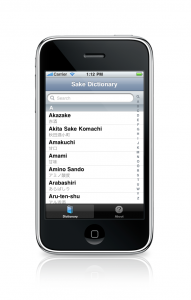 |
|
|
The Sake Dictionary is a concise little package of all the terms you might ever come across when dealing with sake. Almost 200 of them - including sake grades, rice variety names, seasonal sake terms, special varieties, rare types, post-brewing processing words and the myriad terms used in sake production - many of which are not even familiar to the average Japanese person on the street - are listed up here with concise, useful and clear definitions and the written Japanese version as well. And now, with the new audio component, you can listen and learn just how to pronounce those terms properly.
Start to toss around Japanese sake terms like you were raised knowing them! Gain a level of familiarity hitherto unimaginable! Avoid frustrating paralysis when faced with a sake-related purchase!
Get your copy of The Sake Dictionary now and never be confused by sake terms - or how to pronounce them - again.
Get it here: http://itunes.com/apps/sakedictionary
(Note if you have already purchased it, this upgrade to the audio version is free. Just go to iTunes and get it!)
|
Are you not getting this newsletter? I realize that is like asking that
"those not present please raise your hand," but for future reference, should you spontaneously stop receiving this newsletter, please go here and sign up again. Should that not work, please go to www.sake-world.com.
Email newsletter services are very careful not to be considered spam enablers, but the problem is that often very valid email addresses come back bounced as invalid. It is an unavoidable problem. So if you or someone you know is not getting this, or stop(s) receiving it inexplicably, please do take a moment to double check that you are still subscribed.
Sincere apologies for the hassle, mixed with gratitude for reading this newsletter. |
I hope you have found the above information helpful and entertaining. For more information about all things sake, please check out www.sake-world.com. Until next month, warm regards, and enjoy your sake. 
Questions and comments should be directed to John Gauntner, at this email address.
All material Copyright, John Gauntner & Sake World Inc.
Regards,
John Gauntner
Sake World, Inc
 . . 
|
|
